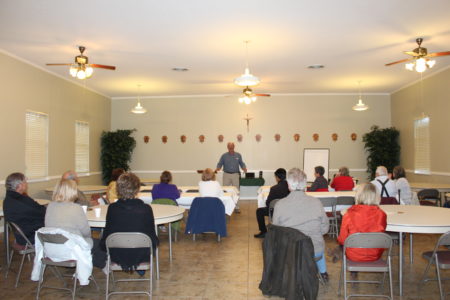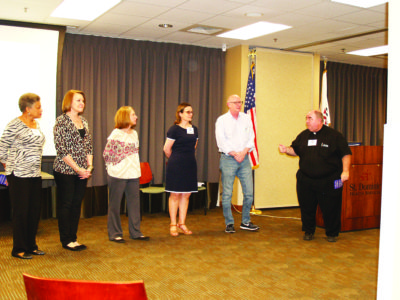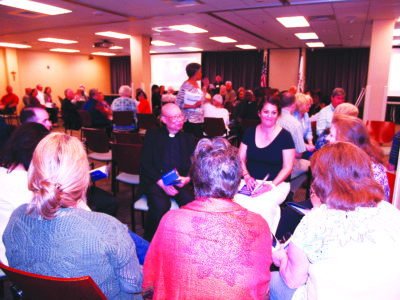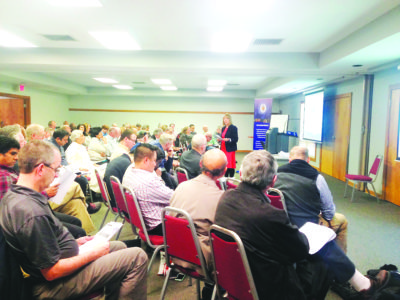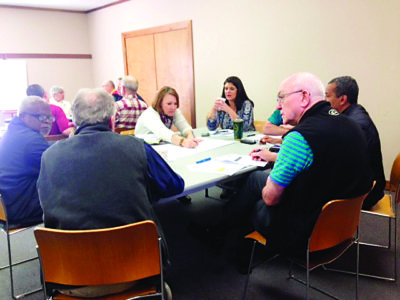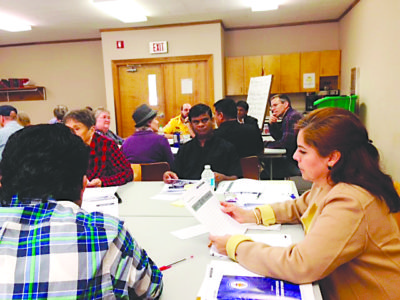By Maureen Smith
JACKSON – In honor of the centennial of the appearance of Our Lady in Fatima, Portugal, and as a way to strengthen the Pastoral Priorities implementation, Bishop Joseph Kopacz will consecrate the Diocese of Jackson to the Sorrowful and Immaculate Heart of Mary on Sunday, Oct. 8.
All are invited to the Mass at the Cathedral of St. Peter the Apostle at 2:30 p.m. After the Mass, the bishop will lead a procession around downtown and present representatives from each parish with prayer cards to take back to their home communities. Bishop Kopacz is asking every parish to offer the prayer as the Pastoral Priority teams start their work. On Saturday, Oct. 7, all are welcome to the cathedral for a a rosary starting at 10:30 a.m.
Outlying parishes can participate by offering a rosary at that hour so the diocese is all praying together. The bishop will also ask parish priests to consecrate individual parishes to the Immaculate Heart the weekend following the diocesan consecration.
When Mary appeared to a trio of poor shepherd children in Fatima 100 years ago, she asked them to spread a message of prayer and repentance. She appeared to the three for six months and asked that people pray the rosary and make sacrifices for sinners. Two of the visionaries, 9-year-old Francisco and 7-year-old Jacinta, became the church’s youngest non-martyred saints earlier this year. Both died young of illnesses. Their cousin, Lucia dos Santos, went on to become a nun. Her cause for sainthood is underway. The three shared Mary’s messages, which included predictions of war, a vision of hell and encouragement to pray and repent.
“This is one way we can ask Mary to guide us and watch over us during implementation (of the Priorities),” said Mary Woodward, chancellor for the diocese.

An image of Mary, taken from a window at the Cathedral of St. Peter the Apostle, is seen on the Pastoral Priority Booklet cover.
Bishop Kopacz pointed out that Mary is already prominent in the Pastoral Priority plan as her image, taken from the rose window at the Cathedral of St. Peter the Apostle, is on the cover of the booklet outlining the Priorities. “The Blessed Mother is almost a subtle presence on our Pastoral Priorities booklet, yet clearly present,” said the bishop. “I think we can safely say she is our model for life-long intentional discipleship – right to the foot of the cross and into the resurrection and Pentecost event,” he continued. ” She gave birth to the incarnate Son and was central to the birth of the Church. As the Mother of the Church I think it is fitting to consecrate the diocese to her intercession and maternal care on the 100th anniversary of Fatima,” concluded Bishop Kopacz.
The Congregation for Divine Worship lists the consecration as one of the devotions approved by the church, but only with a proper understanding of what it is. The Directory on Popular Piety and the Liturgy describes it this way: “The history of Marian devotion contains many examples of personal or collective acts of ‘consecration or entrustment to the Blessed Virgin Mary’ … Seen in the light of Christ’s words (cf. John 19, 25-27), the act of consecration is a conscious recognition of the singular role of Mary in the Mystery of Christ and of the Church, of the universal and exemplary importance of her witness to the Gospel, of trust in her intercession, and of the efficacy of her patronage, of the many maternal functions she has, since she is a true mother in the order of grace to each and every one of her children (253).”
“There is a rich tradition of Marian consecrations in the Church. Many people immediately think of Louis de Montfort’s 33-day consecration – or the spinoff, ’33 Days to Morning Glory,'” explained Deacon Aaron Williams, who composed the prayer to be used in the Diocese of Jackson. Deacon Williams researched different forms of consecration during the process. He also took language from the Pastoral Priorities and the new mission and vision statements.
“Pope Pius XII wrote his own consecration prayer, in response to the request of Our Lady of Fatima, which he urged all priests to make use of in parishes during his reign. We could have naturally looked to any of these prayers, but in the end, I felt it was more fitting for our situation to have a prayer which expressed the goals we had in mind for the consecration of our diocese,” said Deacon Williams.
“I decided to look at a number of consecration prayers and see what elements should be included, and used some elements of the Pius XII prayer as a model. I also wanted to include references which were particular to our own diocese. For example, the Diocese of Natchez was established under the patronage of Our Lady of Sorrows (the titular title of the Basilica in Natchez). So, there was already some form of consecration to Mary in our diocese. The prayer I composed makes the consecration itself to ‘the Sorrowful and Immaculate Heart.’ A later line speaks of Mary as ‘constantly showing [Jesus] the sorrows of [her] heart,'” explained Deacon Williams.
When an individual consecrates themselves to the Virgin, they commit to receive reconciliation, pray a rosary, receive Eucharist and offer certain prayers and meditations on the first Saturday of each month. They put themselves entirely in Mary’s care in their prayers.
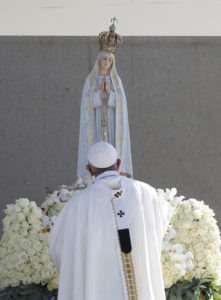
Pope Francis uses incense as he venerates a statue of Our Lady of Fatima during the canonization Mass of Sts. Francisco and Jacinta Marto, two of the three Fatima seers, at the Shrine of Our Lady of Fatima in Portugal, May 13. The Mass marked the 100th anniversary of the Fatima Marian apparitions, which began on May 13, 1917. The Diocese of Jackson will honor the centennial in October when Bishop Kopacz will consecrate the diocese to Mary. (CNS photo/Paul Haring)
“Since this consecration is being done to highlight the envisioning plan, I also wanted the prayer to reference that in some way. One of the intercessions of the prayer quotes the diocesean Mission statement. ‘Help us, Joyful Mother, through your example of living the Gospel, to faithfully proclaim Jesus Christ to be Savior of our hearts,'” said Deacon Williams.
“Finally, as a sort of homage to the Pius XII prayer, I wanted something in this prayer to hint at the ministry of the Holy Father. Pope Francis is often talking about the need to ‘accompany’ people in their journey towards holiness. The prayer I composed speaks of Mary saying, ‘you do not abandon any person who loves your Son, Jesus, but instead accompany the Christian people in true discipleship.'”
Jackson joins a number of dioceses across the nation who have consecrated themselves to Mary this year, including the Archdiocese of San Francisco, Diocese of Kansas City-St. Joseph, the Diocese of Victoria in Canada and the Diocese of Winona, Minn.
Diocesan Chancellor Mary Woodward is working on a brochure to distribute at the consecration with information on the devotion and prayers people can use in their homes with their families.
(Editor’s note: to see the Pastoral Priorites or find the prayer, go to https://jacksondiocese.org/vision/. Download the Prayer of Consecration for the diocese, parishes and families here.)
